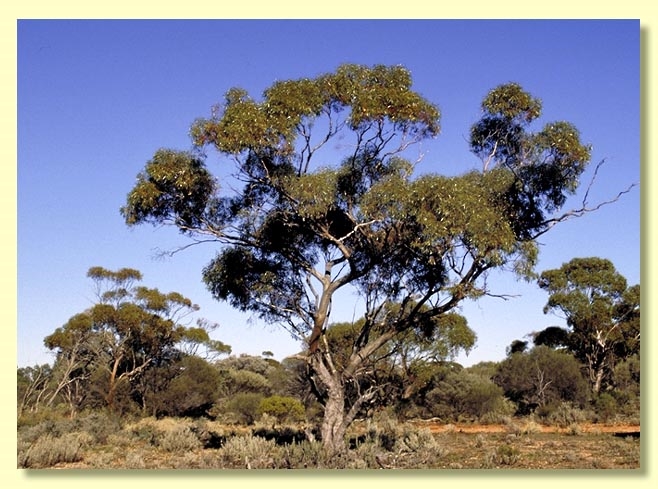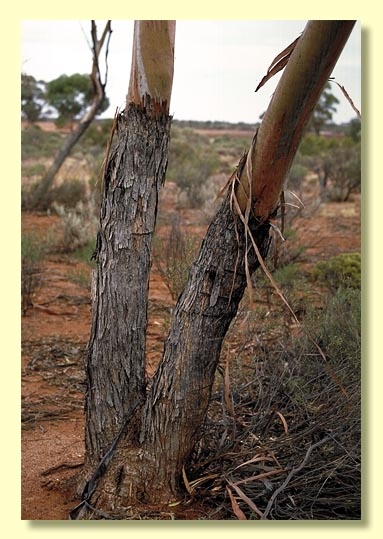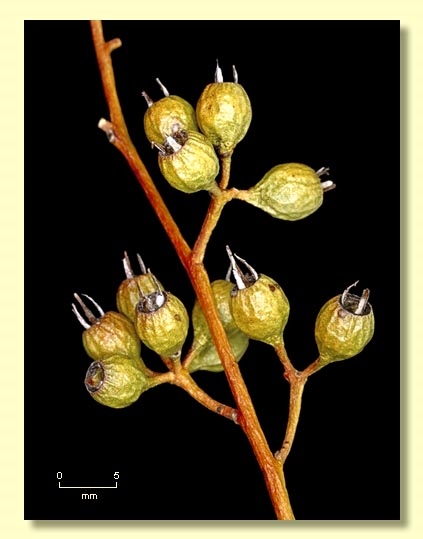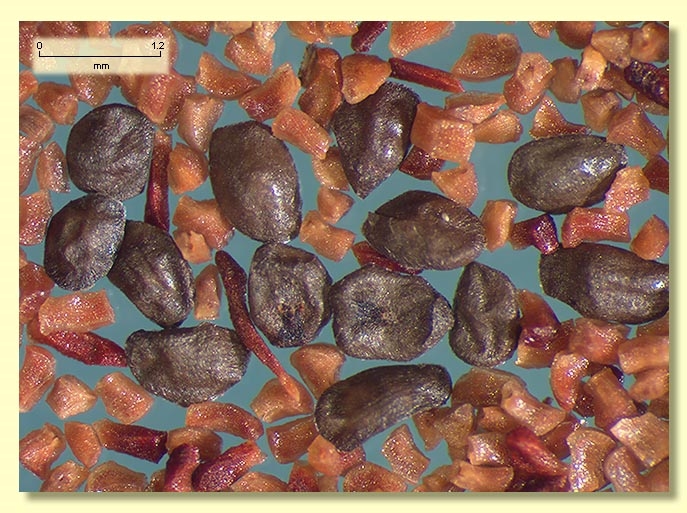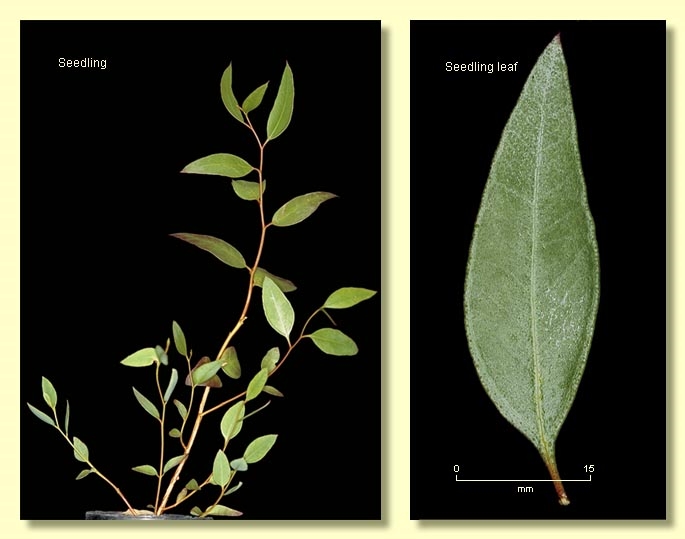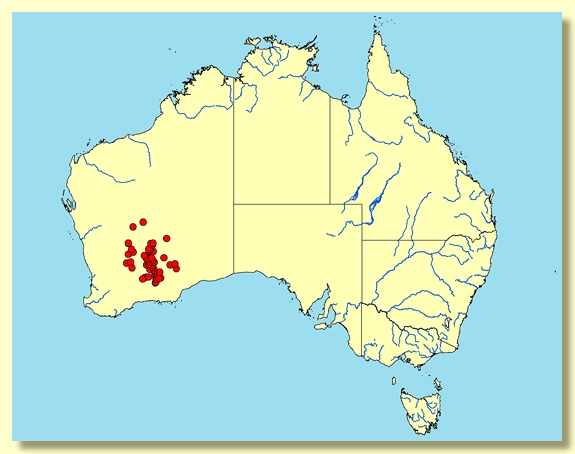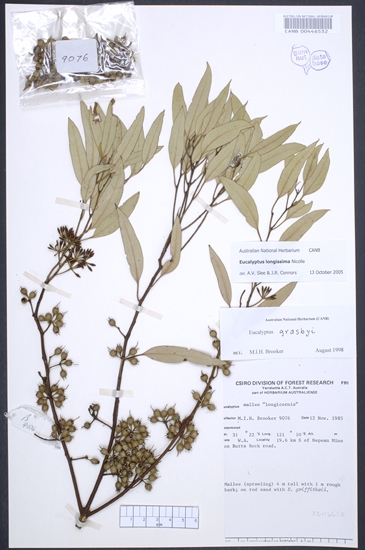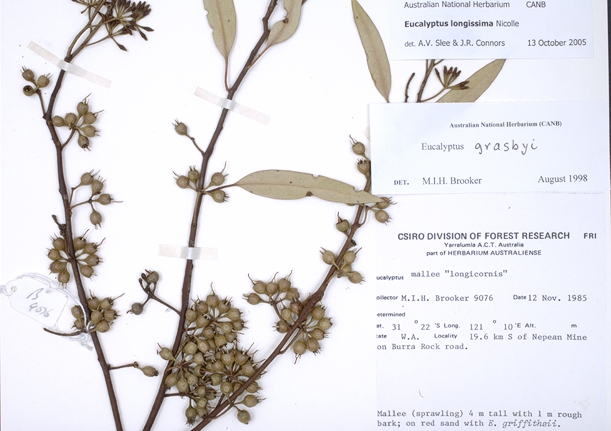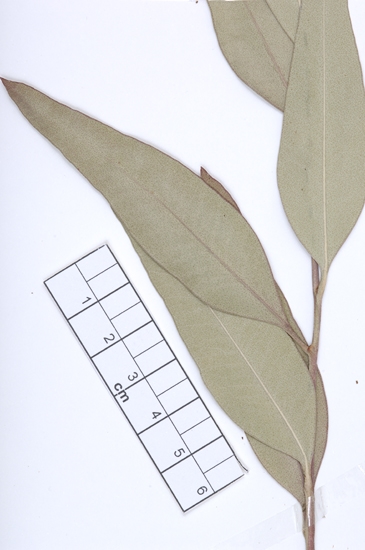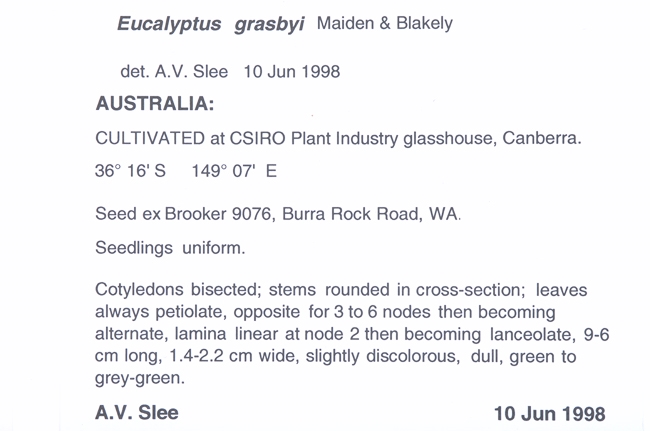Eucalyptus | Symphyomyrtus | Bisectae | Destitutae | Subulatae | Oleaginae
Euclid - Online edition
Eucalyptus longissima
[This species was referred to as Eucalyptus grasbyi. The type specimen of E. grasbyi is now regarded as belonging to E. oleosa, therefore a new name was required for this taxon. See Nicolle, Austral. Syst. Bot. 18 (6) 550 (2005].
Usually a mallee to 8 m tall, rarely a slightly taller tree. Forming a lignotuber.
Bark usually rough over most of the lower stem, hard, fibrous, flaky, grey to brown; occasionally completely smooth-barked, smooth bark grey over coppery-brown, rarely white and slightly powdery.
Branchlets lacking oil glands in the pith.
Juvenile growth (coppice or field seedlings to 50 cm): not seen.
Adult leaves alternate, petiole 1–2 cm long; blade lanceolate, 5.5–11 cm long, 0.7–1.6(2) cm wide, base tapering to petiole, concolorous, glossy green, side-veins at an acute or wider angle to midrib, densely to very densely reticulate, intramarginal vein parallel to and just within margin or, rarely, confluent with margin, oil glands relatively sparse and mostly intersectional.
Inflorescence axillary unbranched, peduncles 0.7–1.7 cm long, buds usually more than 7 up to ?15, pedicellate, pedicels 0.3–0.7 cm long. Mature buds narrowly ovoid to fusiform (0.7–1.2 cm long, 0.2–0.6 cm wide), scar present, operculum conical to horn-shaped (0.4–0.9 cm long), stamens irregularly flexed, anthers adnate to weakly versatile, basifixed, globoid, dehiscing by lateral pores, style long, stigma tapered, locules 3 or 4, the placentae each with 4 vertical ovule rows. Flowers white.
Fruit pedicellate (pedicels 0.3–0.8 cm long), truncate-globose, 0.4–0.6 cm long, 0.4–0.6 cm wide, disc descending, valves 3 or 4, valve tips strongly exserted due to fragile style remnants.
Seeds light brown to grey, 1–2 mm long, ovoid or flattened-ovoid, occasionally with shallow longitudinal furrows on otherwise smooth dorsal surface, hilum ventral.
Cultivated seedlings (measured at node 10): cotyledons Y-shaped (bisected); stems appearing rounded to square in cross-section, rarely slightly warty; leaves opposite, petiolate, dull grey-green for the first 5 to 7 nodes then alternate, petiolate, ovate to lanceolate further up the stem, 5.5–9 cm long, 1.3–3.2 cm wide, glossy to dull green.
Flowering has been recorded in January, February, April, June, August, September and November.
A mallee of the central Goldfields area of Western Australia, from Lake Barlee south-east to the Fraser Range. The bark is rough on the stems and the adult leaves glossy green.
Eucalyptus longissima belongs in Eucalyptus subgenus Symphyomyrtus section Bisectae subsection Destitutae because buds have two opercula, cotyledons are Y-shaped and branchlets lack oil glands in the pith. Within this subsection E. longissima is part of the large taxonomic series Subulatae further characterised by globoid basifixed anthers, grey smooth seeds with shallow longitudinal furrows, and fruit with persistent exserted style remnants. Series Subulatae is divided principally into four subseries based on the juvenile leaves, one with spiral, crowded seedling phyllotaxis (subseries Spirales), another with decussate and decurrent seedling leaves (subseries Decurrentes), another with decussate non-decurrent seedling leaves (subseries Decussatae), and a fourth to which E. longissima belongs with disjunct, petiolate seedling leaves (subseries Oleaginae).
The other members of the subseries Oleaginae are: E. kochii, E. eremicola and E. ultima. Within this group, E. longissima can be distinguished by its often large stature, the intramarginal vein close to the edge of the adult leaf, the long conical operculum, the small truncate-globose fruit and the long slender peduncles and pedicels.
It had been regarded as closely related to E. longicornis, a member of the subseries Spirales, which differs however in the taller stature, tree habit, rough bark over the whole trunk and the spiral, heath-like seedling leaves, typical of that subseries.
The petiolate, disjunct, seedling leaves of E. longissima separate it from another member of the Spirales, E. oleosa, which grows in the vicinity of E. longissima and superficially looks very similar to it. Without seedling leaves, the two species can be very difficult to distinguish. The intramarginal vein of E. longissima tends to be very close to the edge of the margin of the adult leaf, while in E. oleosa, it tends to be further removed from the edge of the adult leaf.

